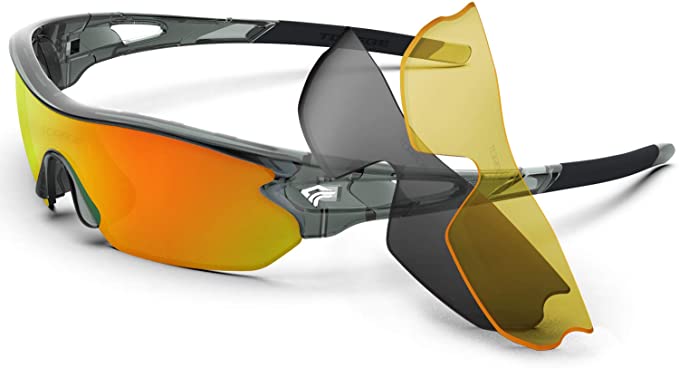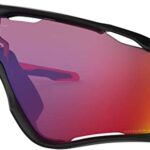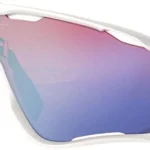Cycling glasses are an important piece of gear for mountain bikers. Glasses protect your eyes from bugs, dirt, dust, and debris that can get kicked up on the trail. They also shield your eyes from harmful UV rays, prevent wind and bugs from drying out your eyes, and improve your vision. For mountain bikers, selecting the right pair of cycling glasses is crucial for safety and performance. There are many options available today with a range of features to enhance your ride.
Protect Your Eyes
One of the main reasons to wear cycling glasses is to protect your eyes. Your eyes are vulnerable on the bike, especially when riding off-road. Mountain biking takes you through wooded areas, over rough terrain, and down steep descents. Along the trail there are overhanging branches, protruding bushes, and stirred up debris that could poke you in the eye. Quality cycling glasses act as a shield to protect your eyes against injury. Most models have impact resistant lenses that are made of polycarbonate or stronger materials. The sturdy frames and lenses prevent things like sticks, rocks, and roost from harming your eyes. Riding without eye protection puts you at risk of a serious eye injury. Wearing cycling glasses greatly reduces the chances of damaging your eyesight on the trail.
Block Debris, Dirt, and Dust
Another key function of mountain biking glasses is keeping debris out of your eyes. When you’re riding off-road, dirt, dust, sand, and mud can be a nuisance. As you roll over the terrain, your tires kick up all kinds of particles. Without glasses, all that grit and grime gets flung into your unprotected eyes. It’s not just unpleasant having dirt in your eyes, but it can also be dangerous if it affects your vision on technical sections of trail. Properly fitted cycling glasses create a barrier to keep debris out. Most models have vents with filters to allow airflow while blocking particles. Some also have foam lining on the inside to seal out dust. Wearing glasses keeps your eyes clear so you can see the trail ahead.
Fight Off UV Rays
Cycling glasses protect your eyes from the sun’s harmful UV rays. Exposure to UV radiation can lead to conditions like cataracts, macular degeneration, and growths on the eye. The risk goes up when you’re cycling because your eyes are fully exposed to the sun. The UV protection coating on cycling glasses lenses filters out 100% of UV rays. This shields your eyes and reduces the chances of developing eye problems later on. Look for glasses labeled with UV400, which indicates they block both UVA and UVB light. Getting glasses with polarized lenses can further reduce glare to make seeing easier on bright days. Protecting your eyes from the sun’s damaging rays is vital for long-term eye health.
Prevent Drying and Irritation
Glasses also guard against wind and insects drying out and irritating your eyes when mountain biking. The constant airflow moving across your eyes as you ride can make them dry, itchy, and uncomfortable. Dirt and allergens stirred up on the trail further aggravate this sensitivity. Cycling glasses form a barrier against the wind so your eyes don’t dry out as quickly. The lenses and closed frame design also keep away bugs and environmental irritants. Models with foam lining help isolate your eyes from particles and allergens floating around. Preventing dryness and irritation means you can focus on the ride instead of constantly dealing with sore, watery eyes.
Enhance Vision and Visibility
Wearing cycling glasses actually improves vision and visibility too. The lenses are optically corrected to ensure minimal distortion. This allows you to see the terrain more clearly and accurately judge lines through technical sections. The frames are designed to provide an unobstructed field of vision with wide lenses and minimal frame edges. The tinting on the lenses enhances contrast so you can better distinguish bumps, rocks, and other obstacles. Mirrored lens coatings also reduce glare to cut through shadows and see the trail ahead. Having crisper vision with cycling glasses lets you spot hazards sooner and react faster. The improved visibility they provide gives you more time to pick your line down the trail.
Increase Safety on Descent
One of the biggest advantages of cycling glasses is how much safer they make high speed descents. Bombing down rough slopes demands full concentration and quick reactions. Squinting against the wind or getting blinded by sunlight can throw off your focus. Dirt and debris flying towards your unprotected eyes is also extremely hazardous at speed. Cycling glasses eliminate glare, block wind and particles, and give you clear vision during fast descents. You can fully see and process the terrain so you don’t misjudge gaps or turns. The improved visibility helps your brain make the subtle adjustments to pick the fastest, safest line down. Wearing glasses greatly reduces the chances of crashing due to impaired vision on technical descents.
Avoid Distracting Lens Fogging
Quality cycling glasses also feature fog-preventing lens coatings so you can see clearly. When lenses fog up from temperature changes or humidity, it obscures your vision and requires stopping to clean them constantly. This can be incredibly distracting and dangerous if it happens during technical riding. Many cycling glasses are treated with anti-fog coatings on the inside surface of the lenses. Some models also have vents in the frame to allow airflow across the lenses. This keeps the inside of the lenses from fogging up by preventing moisture buildup. You’ll have one less thing to worry about if you get glasses treated to resist fog.
Aid Performance with Interchangeable Lenses
Most cycling glasses allow you to swap out the lenses to match different riding conditions. Clear lenses work well in low light like dense woods or at dusk. Yellow or rose tinted lenses improve contrast on overcast days. Mirrored lenses reduce glare on bright days, while dark tinted lenses give the most sunlight protection. Being able to change the lenses means you can tailor your glasses to the current light and maximize their performance benefits. Quick change lens systems make it easy to switch them out between rides. Investing in some extra lenses gives you optimal vision for any mountain biking scenario.
Enjoy Long-Lasting Durability
Cycling glasses are also built to withstand the rigors of mountain biking. The materials and construction make them extremely impact and scratch resistant. Polycarbonate and trivex lenses hold up well to blunt impacts with rocks and crashes without shattering. Durable frame materials like Grilamid TR-90 withstand flexing and retain their shape over time. Full-rim wraparound styles offer the most coverage and protection. Getting sturdy glasses extends their lifespan so you get more use out of your investment. They’ll hold up to years of off-road abuse before needing to be replaced.
Stay Comfortable All Ride Long
For glasses to work well, they also need to fit and feel good. Poorly fitting frames will move around, bounce, and irritate your face. Decent quality cycling glasses are lightweight, flexible, and designed for comfort. Features like adjustable nose pads, interchangeable rubber grippers, and flexible temples ensure a secure fit. This prevents shifting and slipping during rough riding. Breathable frame materials and venting prevent excess sweat buildup behind the lenses. Taking the time to find well-fitted glasses means you can focus on the ride and forget you’re even wearing them.
Comfort and performance often comes down to selecting the right style for your face shape and head size. There are options available for small to large faces with low to high nose bridges. Seeking out a proper fit prevents the annoyance of ill-fitting glasses bouncing on your nose or ears. A quality pair shaped to your face contours provides exceptional comfort and function.
Enjoy Hassle-Free Storage and Changing
Another consideration is how easily glasses store on your helmet and switch in and out between rides. Flexible temples allow some models to conform to helmet curves when storing them atop your helmet. Case design also affects portability, with some models having cases that attach to helmets or gear. Being able to quickly and securely stow your glasses keeps them handy when you need them.
Quick change lens systems make it simple to swap lenses based on light conditions. Look for models with easy release buttons and notches so you can pull the lenses in and out in seconds without fumbling. Well-designed frames and lens cases drastically cut down on the hassle of using your glasses.
Choose Wisely and Ride Confidently
Selecting quality cycling glasses tailored to mountain biking is one of the best investments you can make. They protect your eyes, improve visibility, and enhance comfort. With so many lens and frame options available today, take the time to find the right pair suited to the trails you ride. With a sturdy set of glasses that fit well and meet your needs, you can charge into any terrain with clear vision and full confidence. Keep your eyes protected so you can safely enjoy the trails and vistas. Cycling glasses let you see the world more clearly while guarding your eyesight for years of riding ahead.
If you’re looking for quality eyewear on a budget, there are many cheap cycling glasses options to consider that still offer protection and performance without breaking the bank.



